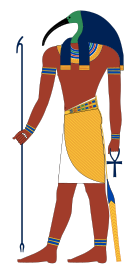থোথ
থোথ (/θoʊθ,
| Thoth | |
|---|---|
 থোথ, তার রূপে একজন আইবিস-মাথাযুক্ত মানুষ হিসেবে | |
| প্রধান অর্চনাকেন্দ্র center | হারমোপলিস |
| প্রতীক | আইবিস, মুন ডিস্ক, প্যাপিরাস স্ক্রোল, রিড কলম, লেখার প্যালেট, লেখনী, বেবুন, দাঁড়িপাল্লা |
| সঙ্গী | মাআত, নেহেমেতাভি |
| সন্তানসন্ততি | Seshat[ক] |
| গ্রিক সমকক্ষ | হার্মিস |
হার্মোপোলিস শহরে থোথের প্রধান মন্দিরটি অবস্থিত ছিল (মিশরীয়: ḫmnw /χaˈmaːnaw/, মিশরীয় উচ্চারণ: "Khemenu", কিবতীয়: Ϣⲙⲟⲩⲛ Shmun)। পরবর্তীকালে মিশরীয় আরবি ভাষায় পরিচিত এল - আশমুনেন নামে থোথের একটি মন্দির ছিল যা খ্রিষ্টিয় যুগ শুরু হওয়ার আগেই বেশিরভাগ ধ্বংস হয়ে গিয়েছিল। এর খুব বড় প্রোনো ১৮২৬ সালে দাঁড়িয়ে ছিল কিন্তু ১৯ শতকের মাঝামাঝি এসে এটি ভেঙে ফেলা হয় এবং একটি চিনি কারখানার জন্য ব্যবহার করা হয়।[৩][৪]
থোথ হারমোপোলিসে আটজন প্রধান দেবতার একটি দেবমণ্ডলীর নেতৃত্ব দেন এবং তখন তার স্ত্রী ছিলেন নেহমেতাউই অন্যান্য শহরেও তার অসংখ্য মন্দির ছিল।[৫]
মিশরীয় পুরাণে থোথ অনেক গুরুত্বপূর্ণ এবং বিশিষ্ট ভূমিকা পালন করেছিলেন, যেমন: এই মহাবিশ্বকে বজায় রাখা এবং দুজন দেবতার মধ্যে একজন হওয়া (অন্যজন ছিলেন মা'আত, যিনি রা'র সৌর বার্কের উভয় পাশে দাঁড়িয়ে ছিলেন।[৬] প্রাচীন মিশরের পরবর্তী ইতিহাসে থোথ ঈশ্বরীয় বিরোধের সালিশের সাথে ব্যাপকভাবে যুক্ত হয়ে ওঠে, জাদুবিদ্যা, লেখার ব্যবস্থা এবং মৃতদের বিচার ।[৭][৮]
আরও দেখুন
সম্পাদনা- খোংশু
- হোরাসের চোখ
- থোথের বই
- The Book of Thoth (Crowley)
- Thout, the first month of the Coptic calendar
- List of lunar deities
- Phaedrus (dialogue)
টীকা
সম্পাদনা- ↑ তার সহধর্মিণীও বলা হয়।
তথ্যসূত্র
সম্পাদনা- ↑ Hieroglyphs verified, in part, in (Budge The Gods of the Egyptians Vol. 1 p. 402) and (Collier and Manley p. 161)
- ↑ Thutmose III: A New Biography By Eric H Cline, David O'Connor University of Michigan Press (January 5, 2006)p. 127
- ↑ Verner, Miroslav (২০১৩)। Temple of the World: Sanctuaries, Cults, and Mysteries of Ancient Egypt (ইংরেজি ভাষায়)। American University in Cairo Press। পৃষ্ঠা 149। আইএসবিএন 978-977-416-563-4।
- ↑ "Destruction of Egyptian Monuments"। Littell's Living Age – উইকিসংকলন-এর মাধ্যমে।
- ↑ (Budge The Gods of the Egyptians Thoth was said to be born from the skull of Set also said to be born from the heart of Ra.p. 401)
- ↑ (Budge The Gods of the Egyptians Vol. 1 p. 400)
- ↑ (Budge The Gods of the Egyptians Vol. 1 p. 405)
- ↑ (Budge The Gods of the Egyptians p. 403)
গ্রন্থপঞ্জি
সম্পাদনা- Bleeker, Claas Jouco. 1973. Hathor and Thoth: Two Key Figures of the Ancient Egyptian Religion. Studies in the History of Religions 26. Leiden: E. J. Brill.
- Boylan, Patrick. 1922. Thoth, the Hermes of Egypt: A Study of Some Aspects of Theological Thought in Ancient Egypt. London: Oxford University Press. (Reprinted Chicago: Ares Publishers inc., 1979).
- Budge, E. A. Wallis. Egyptian Religion. Kessinger Publishing, 1900.
- Budge, E. A. Wallis. The Gods of the Egyptians Volume 1 of 2. New York: Dover Publications, 1969 (original in 1904).
- Jaroslav Černý. 1948. "Thoth as Creator of Languages." Journal of Egyptian Archæology 34:121–122.
- Collier, Mark and Manley, Bill. How to Read Egyptian Hieroglyphs: Revised Edition. Berkeley: University of California Press, 1998.
- Fowden, Garth. 1986. The Egyptian Hermes: A Historical Approach to the Late Mind. Cambridge and New York: Cambridge University Press. (Reprinted Princeton: Princeton University Press, 1993). আইএসবিএন ০-৬৯১-০২৪৯৮-৭.
- The Book of Thoth, by Aleister Crowley. (200 signed copies, 1944) Reprinted by Samuel Wiser, Inc 1969, first paperback edition, 1974 (accompanied by The Thoth Tarot Deck, by Aleister Crowley & Lady Fred Harris)
বহিঃসংযোগ
সম্পাদনা- Stadler, Martin (২০১২)। "Thoth"। Dieleman, Jacco; Wendrich, Willeke। UCLA Encyclopedia of Egyptology। Department of Near Eastern Languages and Cultures, UC Los Angeles।